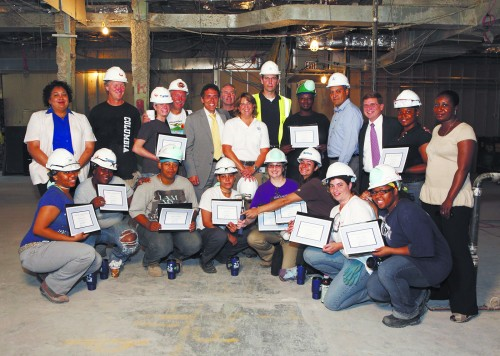Green Salvage Program Provides Training for Local Workers

Reality was ever-present over the summer, as everything from old computers to piles of metal studs were removed by the truckload from the upper floors of the building. (Pitruzzello's office is on the ground floor.) Of the 77 tons of recycled or reused materials, 20 percent was sent overseas, mainly to Nicaragua.
But the effects will also be felt much closer to home, because the sustainable approach was designed to train local minority women and men for jobs in salvage, reuse and surplus management, growing fields in an era of green building. The School of Cooperative Technical Education, a city program that provides job training to at-risk young men and women in Upper Manhattan, and Nontraditional Employment for Women, known as NEW, a nonprofit that trains women for jobs in the construction trades, arranged for approximately 40 women to receive the on-the-job training at Reality House.
"There are a lot of women who want to get dirty, who can do heavy lifting," said Kisa Grate, the program coordinator for NEW. "We want to give those women opportunities to show what they can do."
"This was real nitty-gritty work," said La-Verna Fountain, who heads the University's communications efforts for the Manhattanville project.
Disposition of materials removed from the building was handled by Institution Recycling Network, which worked to ensure compliance with state and federal waste and privacy regulations. As a direct result of the success of the project at Reality House, the network is hiring a crew of workers from NEW for an upcoming project on Governors Island. Also involved was Build It Green! NYC, a nonprofit that matches recycled building products with potential users in and around the city. The group received approximately six tons of materials from Reality House.
"Every piece of material that can be reused or recycled is a piece that doesn't have to be manufactured," said Pitruzzello. "That reduces pressure on landfills and cuts the carbon footprint of the project."
The Reality House program is just one early step in Columbia's commitment to sustainable building practices. This summer Faculty House reopened, after an extensive renovation in accordance with the United States Green Building Council's LEED (Leadership in Energy and Environmental Design) program. LEED awards ratings to buildings that comply with guidelines for sustainable site development, water savings, energy efficiency, materials selection and indoor environmental quality. At Faculty House, the University installed energy-efficient appliances and water-conserving fixtures, and maximized insulation to reduce heating and cooling loads. Recycled materials were incorporated throughout the building. The finishes include paints low in volatile organic compounds (VOCs).
And in a move reminiscent of the Reality House program, kitchen equipment from the building was sent to San Pedro Sula, Honduras, where it became part of a training kitchen at a trade school there.
As planning for the Manhattanville campus continues, Pitruzzello says, environmental concerns are front and center. The University is committed to a minimum of LEED silver certification for each of its new academic buildings. It is also working with the Green Building Council on a pilot program in which the entire neighborhood, not just its individual buildings, is evaluated for environmental soundness.
According to Pitruzzello, it's too soon to know if future demolition projects will permit the kind of piece-by-piece disassembly that characterized the Reality House project. But by working with organizations like NEW, the University ensured that the project wouldn't be a one-time-only thing. Said Pitruzzello, "We've created the infrastructure, and a national model, to be replicated elsewhere."
To view a video of the green salvage project, please visit http://news.columbia.edu/newyorkstories/1703.